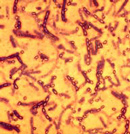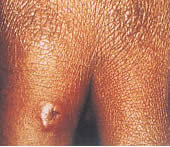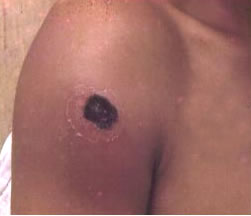Anthrax
Types
| Plague | Anthrax | Smallpox
| Possibilities
Causes
- Anthrax is caused by
the bacteria Bacillus anthacis. This is a bacterium that forms spores.

Image courtesy of CDC
- A spore is a dormant cell that can "wake
up" under the right conditions
- There are 3 types of Anthrax: cutaneous (an
infection of the skin), inhalation (an infection of the lungs), and gastrointestinal
(an infection of the digestive system).
Transmission
- Cutaneous or inhalation anthrax can be transmitted
by handling products from infected animals (such as wool).
- Gastrointestinal anthrax can be obtained by
eating undercooked meat from infected animals
- Anthrax can also be caught by directly handling
the spores
How
to recognize and handle a suspicious package or envelope.
Incubation Period
- Symptoms usually appear within a week
- Inhalation anthrax may take up to 42 days
for symptoms to appear
Effects
- Cutaneous
- Sores
- Blisters

- Skin ulcer with a black area in the center

Image courtesy of CDC
- The sores, blisters and ulcers do not
hurt
- Gastrointestinal
- Nausea
- Loss of appetite
- Bloody diarrhea
- Fever
- Bad stomach pain
- Inhalation
- Cough
- Chest discomfort
- Shortness of breath
- Tiredness
- Muscle aches
Mortality
- Cutaneous
- Untreated: ~20%
- Treated: <1%
- Inhalation
- Around 75% even with treatment
- Gastrointestinal
top of page
© 2003 Jay Farmer, J.P. Oehrtman, and Tim Maluvac. All
rights reserved, except for the images, which retain their own copyrights.
This site is designed by Jay Farmer, J.P. Oehrtman, and Tim
Maluvac for MBI 699.W.
Last modified: August 7, 2003
background courtesy of: http://bt.swmed.edu


